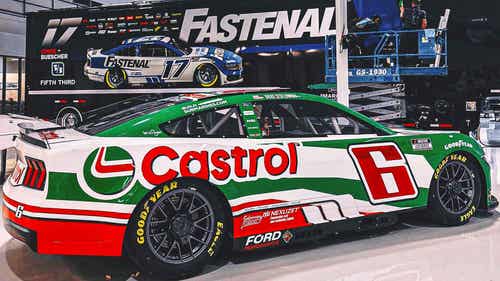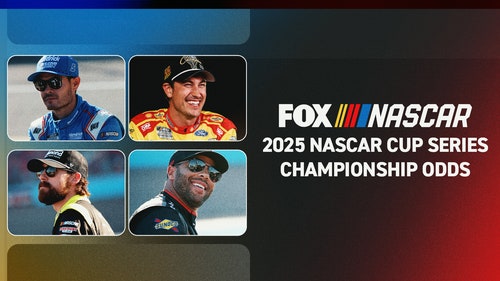
NASCAR: A Fan's Guide To All Of The Changes Made Ahead Of 2017
Feb 21, 2016; Daytona Beach, FL, USA; NASCAR Sprint Cup Series driver Chase Elliott leads Dale Earnhardt Jr during the Daytona 500 at Daytona International Speedway. Mandatory Credit: Mark J. Rebilas-USA TODAY Sports
You may have heard, NASCAR made some changes this offseason. The changes just don’t stop with the new series name, Monster Energy NASCAR Cup Series, either. It’s a whole different NASCAR now.
The 2017 NASCAR season is right around the corner and that means if you haven’t been paying attention in the off-season, you may have missed a change, or four.
The Monster Energy NASCAR Cup Series made changes both on and off-the track for the upcoming 2017 season. The changes run from how the playoff field is set, to which set of tires the drivers will be allowed to start a race with. There are new changes to the format of the races, safety updates impacting whether or not a damaged car can return to the race track and bonus points for the regular-season champion.
If that makes your head spin, don’t worry. We broke down all the new changes for the 2017 NASCAR season.
Jul 2, 2016; Daytona Beach, FL, USA; NASCAR Sprint Cup Series driver Dale Earnhardt Jr. (88) and Martin Truex Jr. (78) race during the Coke Zero 400 at Daytona International Speedway. Mandatory Credit: Jasen Vinlove-USA TODAY Sports
Segments Introduced In All Three Series
NASCAR races will now be broken up into three segments. The segments themselves will be called Stage 1, Stage 2 and the Final Stage and the lengthy of these segments will vary by track and race duration.
The length of Stage 1 and Stage two will be a total of approximately 25-30 percent of the races total length. For example, the stages for the Daytona 500 were announced with Stage 1 and Stage 2 as two 60-lap stages, followed by a final 80-lap stage to make up the 200 scheduled laps.
At the end of each segment during the races, bonus points will be awarded for those drivers running in the Top 10. First place will receive 10 points, second place nine points and so on.
During each stage break, there will be a commercial break and an interview with the winning driver of that segment. This is to help ensure as little on-track action will be missed during the green flag racing.
Once the race has concluded the third and final stage, normal points are awarded. The winner receives 40 points, second place receives 35 points down to one point for the drivers that finish 36th through 40th.
One last thing, there are no longer bonus points for leading a lap or a bonus point for leading the most laps.
There are also bonus points available to the winner of each segment that will be used in the playoffs. Yeah that’s right, it’s now the NASCAR playoffs.
Credit: Jerome Miron-USA TODAY Sports
Playoffs And Playoff Points Replace The Chase
No more Chase, say hello to the playoffs. NASCAR ditched the term “Chase for the Sprint Cup” and will now just use the term playoffs when talking about the final ten races of the NASCAR season.
But that isn’t even the biggest news of all. NASCAR has introduced the term playoff points as well.
At the conclusion of the first two stages of each race, the winner will receive a playoff point that they can then carry into the playoffs if they qualify for the 16-driver field. The winner of each race will receive five playoff points for each race win.
The most important factor in all of this: Playoff points will carry over to every round except once the final four drivers are decided for Homestead. In the final race of the season, the four drivers will race straight up.
NASCAR’s goal is for each race to have heightened competition throughout and in doing so, rewarding the drivers with playoff points who are running towards the front of the field at the end of the first two segments and the final segment.
Credit: Amber Searls-USA TODAY Sports
Regular-Season Champion Finally Rewarded
There was no questioning that many drivers, fans and NASCAR leadership thought that the regular season champion in NASCAR deserved some type of reward after leading the points after the first 26 races.
Now, there finally is a reward. NASCAR Executive Vice President and Chief Racing Development Office Steve O’Donnell hinted at something in the fall of last year, according to Motorsport.com.
“One of the things we’re looking at is (in) the first 26 races, are there some additional things we could do for the winner of the regular season,” O’Donnell said. “I think that’s certainly fair for us to look at — and we are.”
The good news is, NASCAR came through.
The regular-season champion will receive a bonus of 15 playoff points. Second place earns 10 playoff points, third place earns eight, all the way down to 10th place earning one playoff bonus point.
This is different in years past when the regular-season champion didn’t earn anything extra but instead the same number of bonus points (three) for each win they had during the regular season. This led to drivers, who more than likely had a consistent regular-season, end up buried in the points when the first race of the playoffs began due to not having as many wins as other drivers.
If anything is certain, NASCAR is trying to award both consistency and winning, something that hasn’t been done in the last few years.
Credit: Jerome Miron-USA TODAY Sports
Participation Guidelines
Buschwhacker, Kyle Busch haters and everyone else in-between have been asking for years what NASCAR will do to eliminate drivers from the MENCS from competing in the NASCAR Xfinity Series and NASCAR Camping World Truck Series.
Well, there is finally an answer to this.
Monster Energy NASCAR Cup Series drivers with more than five years of full-time experience are limited to ten (10) races in the NASCAR XFINITY Series and seven (7) in the NASCAR Camping World Truck Series.
These guidelines also prohibit those drivers from participating in the final eight races of the season for the XFINITY and Truck Series. Those are the races that include the regular-season finale as well as all of the playoff races in both series.
The rule doesn’t apply to any driver with fewer than five years of full-time experience.
So who would the rule have affected in 2016? According to NASCAR.com:
A total of six full-time Sprint Cup drivers — Busch, Logano, Dillon, Larson, Brad Keselowski and Matt DiBenedetto — have competed in 10 or more XFINITY events. Of those, only Busch, Logano and Keselowski — all with a full-time tenure of five or more years in NASCAR’s premier series — would be affected by the restrictions under the 2017 guidelines.
The impact of this new rule won’t fully be known until the end of the season when there is a much easier way to compare wins from the two seasons.
Feb 21, 2016; Daytona Beach, FL, USA; Damage to the car of NASCAR Sprint Cup Series driver Danica Patrick after crashing during the Daytona 500 at Daytona International Speedway. Mandatory Credit: Mark J. Rebilas-USA TODAY Sports
Safety Improvements On And Off The Track
NASCAR has made two substantial changes to help increase driver and fan safety.
The first is a team of medical responders who will travel with NASCAR each week. NASCAR will be partnering with American Medical Response (AMR) to expand the capabilities of NASCAR’s medical support model and enhance on-track incident response.
Infield Care Centers will continue to be staffed with local emergency room physicians, but now the AMR team will bring their familiarity it will develop with drivers into the Infield Car Centers.
The second change is that race teams in all three series will no longer will be allowed to replace damaged body parts that are the result of accidents or contact. Fixing damaged sheet metal will be allowed but teams will be given only five minutes to fix damage once they enter pit road.
If a team is forced to go to the garage for repairs, the car will not be allowed to return to the race. Also, if the repairs take longer than the five minutes allowed, the car can not return to the race.
Once repairs have been made, the car is still required to maintain the minimum speed determined for the race. Successful damage repair will result in the the five-minute clock to reset in case the car needs to come back down pit road.
This is a big change from previous years when teams could not only replace damaged parts with no time limit, but were allowed to go the garage and come back out on the track to race.
This rule will hopefully eliminate untimely debris cautions as damaged cars continue to race and also eliminate the chance of debris to injure spectators on pit road or in the grandstands.
Sep 4, 2016; Darlington, SC, USA; Sprint Cup Series driver Kevin Harvick (4) makes a pit stop during the Southern 500 at Darlington Raceway. Mandatory Credit: Peter Casey-USA TODAY Sports
NASCAR Rules Package Updates
In an effort to continually provide the best on-track product, NASCAR is introducing a few more changes to their rules package for the 2017 season.
For starters, NASCAR is reduce downforce with the 2017 rules package even further than in 2016.
The downforce is expected to be around 1,500 pounds, this is a reduction of about 500 pounds from 2016. The spoiler will also be shorter in 2017.
Here are the changes broken down in detail from NASCAR.
In addition, at 28 of the 36 points-paying races there will be a a reduction in the number of tire sets in a race. Also, Monster Energy NASCAR Cup Series teams will be required to start the race on the tires used during qualifying.
With all of these changes, it’s safe to say the 2017 Monster Energy NASCAR Cup Series will be unlike any other season.
More from Beyond the Flag
This article originally appeared on











